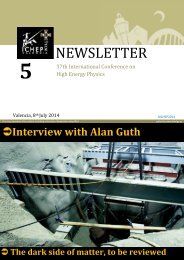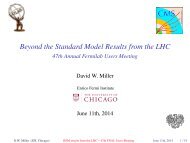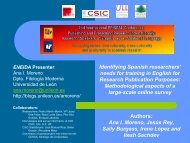PW_mar13_sample_issue
PW_mar13_sample_issue
PW_mar13_sample_issue
You also want an ePaper? Increase the reach of your titles
YUMPU automatically turns print PDFs into web optimized ePapers that Google loves.
Quantum frontiers: Quantum simulation<br />
At a glance: Quantum simulation<br />
● The idea of quantum simulation originated in a 1981 lecture<br />
by Richard Feynman, in which he suggested that simple,<br />
controllable quantum systems could be used to simulate the<br />
quantum dynamics of problems that cannot be modelled by a<br />
conventional computer<br />
● Ultracold atoms trapped in optical lattices are a good candidate<br />
for performing such simulations, thanks to the high degree of<br />
control that experimentalists have over important parameters<br />
such as the position of the atoms and the geometry of the lattice<br />
● Recent experiments have obtained high-resolution images of<br />
atoms trapped in these optical lattices, and also used laser<br />
beams to flip the spins of individual atoms in a controlled way<br />
● Future experiments with ultracold atoms may enable us to<br />
simulate the effects of very high magnetic fields on real<br />
materials, and perhaps even observe new phases of matter<br />
48<br />
allow them to work around this fundamental problem,<br />
and in many cases these techniques have given<br />
us good answers to specific problems. However, in<br />
other systems, especially where the electrons interact<br />
strongly with each other, these approximations<br />
fail or become invalid as a result of the rapid growth<br />
of entanglement effects in many-body systems. This<br />
rapid growth can be especially severe for a system<br />
that has been pushed far from equilibrium and then<br />
allowed to evolve. But does this mean we have to give<br />
up on trying to understand how these quantum manybody<br />
problems work? Or is there another solution?<br />
Richard Feynman certainly thought there was. In<br />
his visionary 1981 lecture “Simulating physics with<br />
computers” Feynman outlined a radically different<br />
approach to this fundamental problem: he suggested<br />
that it might be possible to use highly controllable<br />
quantum systems to simulate the quantum dynamics<br />
of other – classically intractable – problems. The<br />
idea of a “quantum simulator” was born – a “quantum<br />
machine that could imitate any quantum system,<br />
including the physical world”.<br />
As with many of Feynman’s brilliant ideas, this one<br />
has taken some time to take shape in practice. Within<br />
the past few years, however, groups around the world<br />
have begun to build such quantum simulators in<br />
many different physical implementations, including<br />
Bose–Einstein condensates, degenerate Fermi gases,<br />
photons, trapped ions and arrays of superconducting<br />
qubits or quantum dots. These systems all have<br />
the virtue of being tunable, meaning that all their<br />
interactions, potentials and other parameters can be<br />
engineered to suit a certain model. Thanks to this<br />
property, there is a very good chance that we will be<br />
able to use such model systems to realize completely<br />
new forms of matter under extreme conditions that<br />
cannot be achieved in any other system – and in the<br />
process, start to investigate some previously intractable<br />
problems.<br />
Trapped in a lattice<br />
The root of many condensed-matter problems lies in<br />
understanding the behaviour of electrons in a solid.<br />
In the simplest approximation, such electrons can<br />
be described as moving through a periodic potential<br />
physicsworld.com<br />
Simulations machine Christof Weitenberg working on the experimental set-up at MPQ.<br />
generated by the positively charged ionic cores of the<br />
atoms that make up the solid, which are arranged in<br />
a lattice structure. One way to create such a periodic<br />
potential in the laboratory is to use an “optical lattice”<br />
formed by laser beams. When the beams are<br />
superimposed on each other, their optical interference<br />
generates a pattern of regularly spaced potential<br />
wells. These wells are deep enough that atoms<br />
that have been cooled to temperatures just above<br />
absolute zero can be trapped in them, like eggs in<br />
an egg carton. These ultracold atoms then experience<br />
the lattice pattern of dark and bright regions<br />
as a perfect, defect-free, periodic potential and can<br />
move from one lattice site to the next via quantummechanical<br />
tunnelling.<br />
The great advantage of such a set-up is that many<br />
parameters of this periodic potential are under the<br />
complete control of the experimentalist. For example,<br />
the depth of the wells can be easily changed by<br />
adjusting the intensity of the laser beams, and the<br />
lattice’s geometry can be shaped by interfering laser<br />
beams under different angles. This flexibility allows<br />
researchers to create any geometrical pattern, from a<br />
simple cubic-type lattice structure to triangular and<br />
hexagonal lattices like those found in graphene.<br />
In recent years, the collective behaviour of interacting<br />
bosonic and fermionic atoms in such optical<br />
lattices has been a major focus of investigations with<br />
ultracold atoms. Then, in 2011, prospects for using<br />
ultracold atoms to perform quantum simulations<br />
took a dramatic step forward when two research<br />
teams (led by Markus Greiner at Harvard University<br />
and Stefan Kuhr and myself in Munich) reported<br />
that we had successfully obtained high-resolution<br />
images of individual atoms in an optical lattice. The<br />
resolution of the imaging in these so-called “quantum<br />
gas microscopes” is so good that we can discern<br />
the occupation of neighbouring lattice sites. To put<br />
that into perspective, if we had this kind of resolution<br />
in a real electronic material, we would be able to take<br />
single snapshots of the position of all the electrons in<br />
the material.<br />
The way the experiments work is that ultracold<br />
atoms in a Bose–Einstein condensate (BEC) – an<br />
exotic state of matter in which all the component<br />
Physics World March 2013<br />
Thorsten Naeser, MPQ








